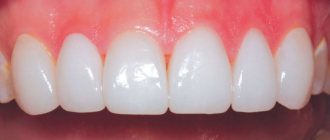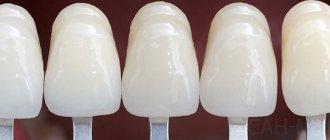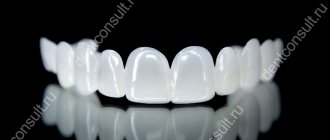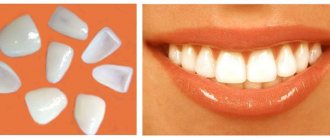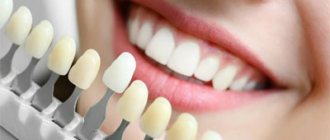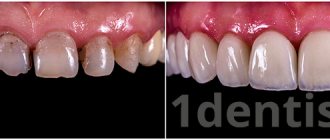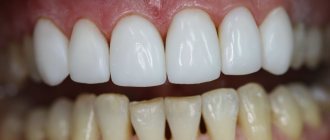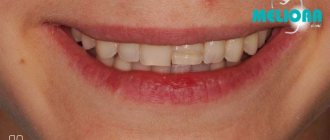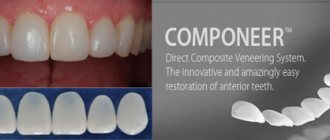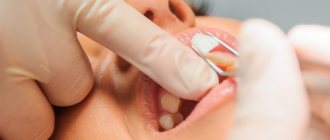Not all people can boast of perfect teeth, despite the fact that the standard of living is now much higher than in previous years and even centuries. Hereditary diseases, drug abuse, and injuries can sometimes cause problems and make smiles look unhealthy and unattractive.
But now such troubles can be dealt with with the help of veneers - thin plates that cover minor defects on the front of the teeth and correct their aesthetics. Installation of such overlays often requires preparation of the enamel, which does not seem like a wasteful action.
Benefits of veneers
All those shortcomings that dentists previously proposed to correct by installing crowns are now quite successfully masked with veneers. This:
- Cracks and chips in enamel;
- Darkening, spots;
- Areas with erosion of tooth enamel;
- Tetracycline teeth;
- Uneven cutting edges;
- A slight rotation of the tooth around the central axis, etc.
Emax veneers are considered the best aesthetic solution in microdental prosthetics. The surface of plates made of artificial material of natural origin reliably imitates the transparency, shine and color of human enamel, so those around them perceive the teeth as “native”.
Why is preparation necessary?
Orthopedic treatment often requires the dentist to resort to grinding of the enamel. Such pre-treatment ensures the most durable attachment of the prosthesis to the surface of the tooth and its hermetically sealed coating. A few years ago, the procedure was painful and traumatic, which scared patients away and left bad memories. Nowadays, enamel preparation is performed using minimally invasive methods, using high-tech equipment, quickly and without experiencing painful sensations.
Nevertheless, patients continue to express concerns and ask whether this step can be avoided when installing veneers. However, in the vast majority of cases it is unlikely to be possible to completely avoid preparation. The reason is the high requirements for the quality of contact between the plate and the tooth. The surface of the enamel is never perfectly smooth; there are always microscopic tubercles, grooves, and depressions. If the veneer does not fit tightly, these cavities become the focus of bacterial masses.
In addition, the enamel is removed before the veneer is placed to reduce the final thickness of the tooth. When a plate is applied without preliminary preparation, the tooth will become larger and more massive, which will not beautify the smile and cause functional discomfort to the person.
The third reason for preparation will be a large amount of carious tissue. To eliminate the possibility of further damage to the tooth under the veneer shield, they will need to be removed.
But under some circumstances, when installing veneers, the dentist leaves the patient’s teeth intact.
When preparation for veneers is not necessary
Preparation of enamel is practically not required if a person has direct veneers made from composite mass. This is a special type of correction of the external surface, when the doctor layers a special material on the enamel. The procedure is performed in one clinic visit. However, composite veneers delivered without any treatment are still a rather rare case.
Ceramic veneers are made in a dental laboratory using a synthetic impression. Here it is important to tightly and firmly attach the plate to the tooth tissue, so grinding down the enamel is a necessity.
Exceptions to the rules when tooth preparation will only harm quality veneering:
- Visual correction of tooth rotation is assumed;
- Severe initial wear of the enamel;
- There are irregularities in the cutting edge of the tooth;
- The vestibular surface of the tooth requires thickening.
When installing any types of veneers - ceramics, porcelain, composite - you will have to remove the enamel if it is destroyed by caries. It is impossible to preserve the pathology under the veneer.
In exceptional cases, for example, when restoring a missing tooth wall, preparation as such is not performed. The doctor simply adds some roughness to the enamel so that the plate clings better to the surface being corrected.
General principles of stitching
When grinding for veneers, the orthopedic dentist is guided by the minimum need, as well as the condition of the tooth itself on which the inlay is installed. This is due to the fact that a high-quality connection between the plate and the stump is possible only in the presence of tooth enamel, which is why it is so important to preserve it.
But it will also not be possible to keep it completely intact, since the artificial element has its own thickness, which increases the size of the tooth, and the connection in this case will be unreliable.
Preparing teeth for veneers provides the following effects:
- fixes the plate efficiently;
- masks the connection point;
- maximizes service life;
- reduces the risk of damage to the product.
Installation of artificial elements can be done without turning, but, as a rule, such prosthetics are carried out to eliminate any minor cosmetic defects and such a prosthesis will not last for a long time. That is why the vast majority of dentists first fully process the tooth enamel and only then fix the plates.
Installation principle
Modern onlays - lumineers and ultraneers - do not require preparation. To install them, you only need to roughen the enamel. But they also cost an order of magnitude more.
What happens if you install an Emax veneer without grinding?
A doctor who cares about his own reputation will never agree to glue a veneer without preparation if he is absolutely sure that treatment is necessary. The patient should trust a qualified specialist to be satisfied with the result. Let's try to imagine what will happen if you put a veneer on a solid tooth in violation of the technology requirements:
- Significant darkening will remain visible even through the surface of the Emax veneer. Thin lumineers are especially translucent, so even when choosing these expensive porcelain onlays, turning is sometimes required.
- Despite the relatively small thickness of the ceramic plate, it still looks bulky on unprepared teeth: it adds volume, looks unnatural, and sometimes even interferes with articulation and chewing of food.
- A ledge often forms above the Emax veneer, near the gums, where plaque and bacteria accumulate. Pathogenic flora is also able to penetrate between the surface of the tooth and the plate itself. In such gaps it develops unhindered, causing caries and its complications.
Many patients are misled by advertising articles that say that it is possible to remove Emax veneers from unground enamel and thereby return the teeth to their natural appearance. This statement is erroneous, since veneers made from this material are relatively thick, and therefore always require paring, unlike ultra-thin veneers without grinding Luxneers and American lumineers (Lumineers).
Indications and contraindications for installation
Indications:
- Minor enamel defects - chips, cracks
- Pigmentation of the enamel layer that cannot be lightened
- Slightly crooked teeth
- Slight crowding of teeth in a row
- Unattractive shape of dental elements (or their small size)
- Enlarged interdental spaces (diastemas and trema)
- Increased abrasion of the enamel layer
Contraindications:
- Complex occlusion defects
- Diseases of teeth and gums (temporary ban)
- Severe destruction of the prosthetic element (more than 45%)
- Passion for hazardous sports (boxing, hockey)
- Bruxism
Note: if the patient is ready to wear a mouthguard every night at night, then veneers can be installed for bruxism.
Preparation methods
The latest methods of grinding down enamel to install artificial overlays involve gentle processing technology and high-precision equipment.
Laser method
A beam of polarized light acts on the hard tissues of the tooth. The moisture contained in them evaporates, and many hydraulic shocks occur, as a result of which the enamel is destroyed.
The advantages of the technique are the speed of impact, the absence of pain and the silent operation of the laser system. It is no secret that the buzzing of a drill is considered one of the most unpleasant auditory stimuli. There is no need for preliminary sanitation of the oral cavity, because the laser perfectly burns out all microflora in the treated areas.
It should be noted that working with a laser requires a steady hand and high qualifications from the dentist, and the professionalism of a specialist is usually well paid. In addition, laser treatment is superficial. If, for example, caries penetrates deep into the enamel, additional exposure will be required.
Ultrasonic treatment of enamel
Ultrasonic treatment of enamel also does not involve preliminary anesthesia - except in extreme cases, with tooth hypersensitivity. Under such exposure, tissues do not overheat and are not destroyed excessively - only within the required limits. Many doctors consider ultrasound as most appropriate in preparation for veneering.
Install veneers without grinding Luxneers teeth at Dr. Lopaeva’s clinic
Make an appointment
Or call +7(985)532-21-01
Chemical treatment of teeth
Preparation of enamel using this technology includes treating teeth with softening pastes. As a result, the outer tissue is easily removed. The disadvantage of this method is the duration of the procedure: the chemical composition requires time to act, approximately 30 minutes.
The advantages are significant:
- Painless;
- No overheating or thermal injury to tissues;
- The risk of excess enamel chipping and cracks is eliminated.
Tunnel preparation method
Grinding using this method will require the use of a special turbine unit. The doctor uses a multi-speed bur with a diamond tip. This treatment is used more often than others and allows for extremely precise control of the degree and depth of impact on the enamel.
The disadvantages of the procedure include pain (anesthesia is required) and increased requirements for equipment. The turbine greatly overheats the tooth tissue. If the device does not have a special cooling device, the patient will be injured. If you work carelessly with a bur, damage to soft tissues is possible - the dentist should not be distracted by anything while working.
Air abrasive method
This method is used only for treating the outer layers of tooth enamel and is used in combination with other methods. The principle of operation of a special installation is to influence the tooth with abrasive powder ejected under pressure. The enamel is removed painlessly and quickly. In this case, it is possible to avoid excessive heating of the organ tissues.
The choice of tooth preparation technology can be planned in advance during a consultation with a doctor. Not every clinic has the full range of equipment; the condition of the patient’s oral cavity and his individual reaction to the technique are also taken into account.
What does your ideal smile consist of?
Many people are now wondering where the “exorbitant” price tags for this procedure come from. I will clearly explain why you shouldn’t do yourself a disservice and go along with many supposedly tempting offers. Please try now to think about what makes up the “Hollywood smile” of our clients. Firstly, these are high-quality materials, which we discussed in detail just above, secondly, this is the maintenance of expensive equipment, thanks to which neither your hand will slip, nor you will be afraid of just the sight, and finally, this is the work of your humble servants: we - qualified dentists, surgeons, implantologists, orthodontists and, of course, anesthetics, so that when you leave the office you can fully enjoy the result and your appearance without experiencing pain or discomfort.
Stages of preparation for Emax veneers
- Making horizontally directed depressions on the vestibular part of the tooth, which determine the extent of penetration into the enamel. The depth is controlled using a diamond bur. The treatment boundary is prepared to the gum, including the lateral surfaces.
- Carefully remove the enamel layer to a depth of no more than 1 mm. Sometimes it is necessary to thoroughly intervene in living tissue if the carious lesion is extensive. The integrity of the cutting edge of the teeth is also affected.
- The prepared area is polished, coated with a degreasing agent, thoroughly washed and dried. Before the final installation of the veneer, the tooth surface is etched with a special chemical composition that increases the adhesion of the surface to the prosthetic material.
Service price
Services for installing veneers with minimal grinding are provided by the best orthopedic dentists in Moscow. The cost of veneers with minimal grinding of teeth directly depends on the level of the clinic, the professionalism of the doctor and the selected material. This also includes the work of dental technicians and medical personnel.
The high cost is justified by the need for careful work to recreate the transparency of the enamel and its microrelief, the complexity of color transfer and restoration of the tooth structure.
Highly artistic veneers, invisible in the oral cavity, which look absolutely natural, cannot cost 30 thousand
rubles.
The price of such products starts from 50-60 thousand rubles. for one unit. Records made from aesthetic materials made in America will cost even more, however, they will last at least 15 years.
Preparation for ceramic veneers
Ceramic veneers today are unrivaled if we analyze the demand for correction of the smile area with artificial overlays. Silicon oxide-based structures are durable, and their ability to reflect light rays is similar to the properties of natural enamel. Therefore, ceramic veneers are indistinguishable from real teeth.
The big advantage of these products is their resistance to staining and oxidation by food compounds, as well as a long service life compared to composite plates.
There is no single preparation algorithm for the installation of artificial onlays. The process is invariably individual and will differ for each patient. The procedure depends on the type of veneer - direct or indirect, on the location of the tooth in the patient’s mouth, on the presence of carious lesions and the volume of fillings.
Failures are not excluded in veneering. One of the factors of poor aesthetics of installed plates is improper preparation of the enamel. This is done in two ways:
- An indirect method used when installing similar veneers. Such plates cover the entire outer surface of the tooth, so it is important to remove the enamel so that the adhesion of the veneer and the prepared surface occurs perfectly. If the layer is removed too finely, the effect of horse teeth is possible, when the veneer makes the tooth visually massive and unnatural.
- The direct method is used when placing direct composite veneers. Here, it is often not necessary to completely remove the enamel; it is enough to expose individual areas.
There is no need to worry about preparing the enamel before installing the veneer. Today, the action is performed carefully in relation to living tissues and is completely painless. A thoughtful choice of clinic and specialist will be the key to high-quality installation of veneers and your healthy and beautiful smile.

